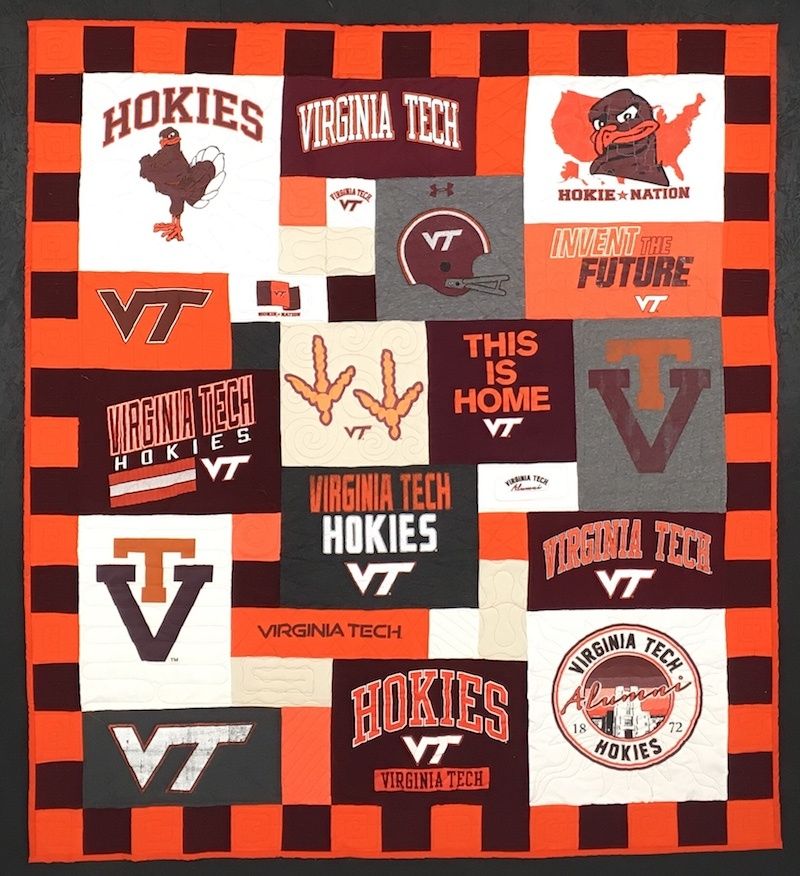10 Common Mistakes in a T-shirt Quilt
1. Cropped Off Logos and Graphics
2. Intersections That Do Not Perfectly Meet
3. Blocks in Sideways or Upside-Down
4. Inconsistent Blocks Shape
5. Tucks in Seams
6. Blank Blocks Sewn Inside Out
7. Holes in Seams
8. Nothing Holding the Front and Back of the Quilt Together
9. Cheap Fabric
10. Cheap Batting
5. Tucks or Wrinkles in Seams
A seam is where two pieces of fabric come together. Seams should be smooth and wrinkle free.
A seam with a tuck on one side indicates that one piece of material was longer than the piece to which it was being sewn. Thus a “tuck” had to be taken in the longer piece so it could be sewn to the shorter piece.
A quilt maker must accurately cut and sew together the T-shirt blocks. A tuck in a seam shows that a quilt maker did not proof their work for errors. Tucks are errors and usually can be fixed.
The first photograph here shows what a seam should look like. The second photograph show a tuck in a seam.


Mistakes That Are More Difficult to Spot
The following mistakes typically can’t be seen from looking at a photo of a T-shirt quilt. You are more likely to see these errors when look at a T-shirt quilt in person.
6. Blank Blocks Sewn Inside Out
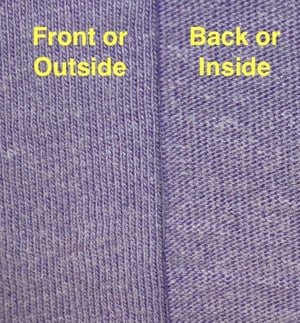
Blank blocks of T-shirt material are used to make borders or to fill out empty spots on a quilt. Some quilt makers use these more often than other quilt makers.
T-shirt material has a right side and a wrong side. In other words, an inside and an outside. Look at your own T-shirt and compare the inside with the outside of the T-shirt. Can you see the difference?
It can be difficult to see because it is subtle and you might need better glasses. One of the first test we have for prospective employees is to see if they can tell the difference. If they can’t, then they are not offered employment.
When a quilter puts a filler or other piece of T-shirt material in the quilt inside out, it’s a mistake. We carefully proof our quilts to make sure that we don’t have pieces of blank T-shirt material in wrong side out.
This is very difficult to spot in a photograph of a quilt. But when you are looking at a quilt in person, you can see this error. It’s not the world’s worst T-shirt quilt error, but it is an error nevertheless.
7. Holes in Seams
 A seam is where two pieces of fabric are sewn together. The outside of the seam should lay smooth and flat. The inside of a seam should have the same amount of seam allowance shown on each side. See the photo here for an example of how the inside of a seam should look.
A seam is where two pieces of fabric are sewn together. The outside of the seam should lay smooth and flat. The inside of a seam should have the same amount of seam allowance shown on each side. See the photo here for an example of how the inside of a seam should look.
But not all seam look like this. The two pieces of material must line up perfectly before the seam is sewn. If not, there is a chance that one side of the fabric might not get caught in the seam. This leaves a hole in the seam. Sometimes the hole can be large enough to put your finger in!
The first photograph here shows what a hole on the front might look like. The second photograph is the backside of the same seam. Here you can see that the seam allowance is non existent on the red piece of material. The seam allowance on the yellow material is correct.


Some quilters don’t not check their seams from the back to see if they are sewn completely. A hole indicates that a quilter didn’t care enough to check his or her work. This is a huge mistake. And a big issue for the quilt’s longevity!
8. Nothing Holding the Front and Back of the Quilt Together
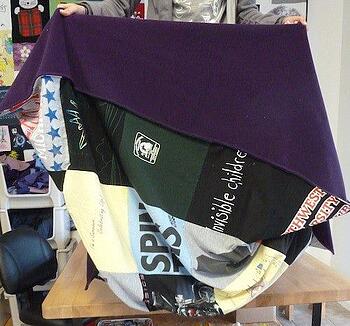
If your “quilt” comes back without any stitching holding the front and back of the quilt together, you actually have a blanket.
The person who called it a quilt either lied to you or does not know the difference. Avoid making this error! Read more about the difference between quilts and blankets here. With this information, you can avoid receiving a blanket when you wanted a quilt.
In the photograph here, you can see that on this blanket, the purple backing material is not connected to the T-shirts on the front. This is a sure sign that you have a blanket and not a quilt. A blanket has a much shorter life expectancy compared to a quilt.
Mistakes You Need to Ask About
The following mistakes can’t be seen from looking at a photo or seeing a T-shirt quilt in person. These errors you might be able to feel. We recommend you directly ask about these two items.
9. Inexpensive Fabric
Inexpensive quilts typically are made from inexpensive materials. Using inexpensive backing fabric can save a quilter a lot of money. To off-set the low purchase price, a quilter will skimp on the quality of materials used. Read more about that here.
This is ultimately a mistake you can avoid making. Ask what types of backing fabric is your quilter uses. Look for the answer of high quality quilters 100% cotton fabric. Think of bed sheets. Read more about backing materials and fabrics here.
You can’t tell from a photograph about the quality of fabric used. You will need to ask.
10. Cheap Batting
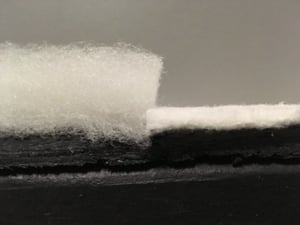 Unlike cheap backing fabric, you can’t see cheap batting. You might not even know that you're quilter used cheap batting. But, sooner or later you will know. You will know when the batting ball up after you wash your quilt. Or you will see the fibers poke out the back of your quilt. This makes the back of your quilt will look a little harry.
Unlike cheap backing fabric, you can’t see cheap batting. You might not even know that you're quilter used cheap batting. But, sooner or later you will know. You will know when the batting ball up after you wash your quilt. Or you will see the fibers poke out the back of your quilt. This makes the back of your quilt will look a little harry.
In the photograph here, the cheap batting is on the left. It's much thicker than good batting. The loft of polyester batting can be a give away about the type of batting used in your quilt.
Please note, a thicker batting does not equal good batting! Polyester battings are bad and cotton battings are good.
You need to ask what type of batting your quilter will be using. Read more about types of batting here.
Conclusion
These are your T-shirts you are hiring someone to transform into a quilt. Make sure the quilt you get back is one that you are proud to show off. And one that will last for generations.
Want to learn more about T-shirt quilts? Visit our Learning Center.
We have over 200 articles about all aspects of T-shirt quilts.

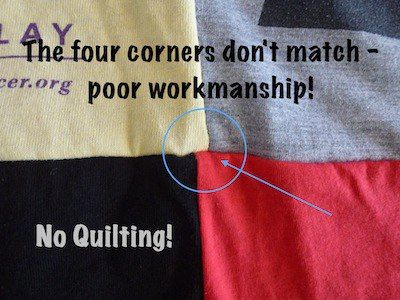
 .
. 
 An intersection in a quilt is when four corners come together. When four corners come together in a quilt, they should meet perfectly. When they are off, they look like the intersection in the photograph here.
An intersection in a quilt is when four corners come together. When four corners come together in a quilt, they should meet perfectly. When they are off, they look like the intersection in the photograph here. Unless requested, all the blocks in a quilt should be in the same orientation. This is the orientation that they were cut from the T-shirts.
Unless requested, all the blocks in a quilt should be in the same orientation. This is the orientation that they were cut from the T-shirts.
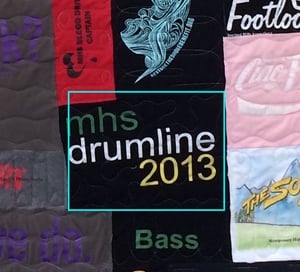 Most T-shirt quilts are made up of squares and rectangles. This means the top and bottom of any block will be the same width. A block with one side wider than the opposite side is called a
Most T-shirt quilts are made up of squares and rectangles. This means the top and bottom of any block will be the same width. A block with one side wider than the opposite side is called a 

